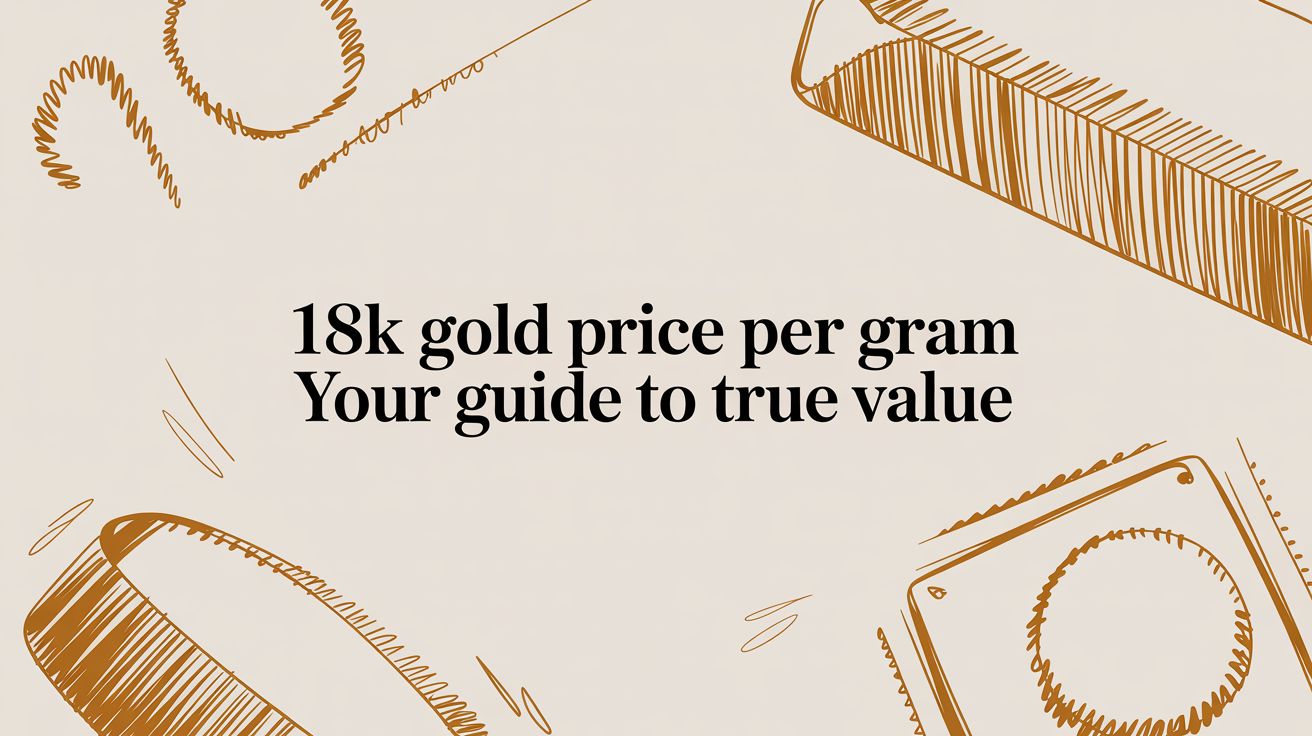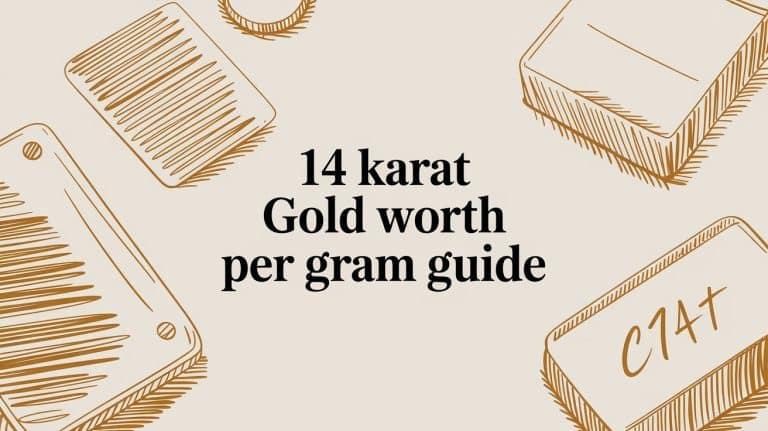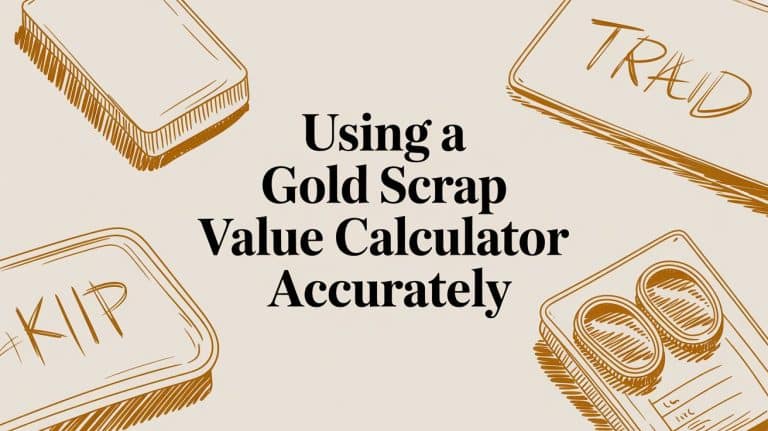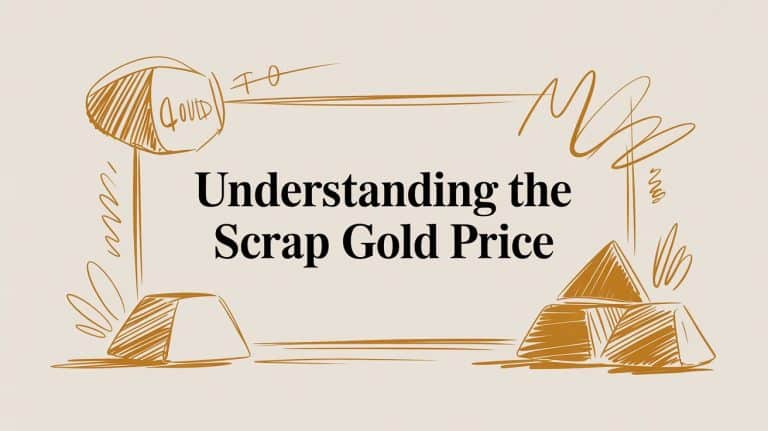18k Gold Price Per Gram Your Guide to True Value
When you look at your jewelry, its value is tied directly to the daily 18k gold price per gram, a figure that’s based on the live, global price of pure gold. Pure gold is actually too soft for most accessories, so it’s mixed with other metals to make it more durable. When you see “18k,” it’s just a shorthand way of saying the item is 75% pure gold.
That percentage is the real key to figuring out what it’s truly worth.
Understanding the True Value of 18k Gold

Ever wondered what makes your 18k gold jewelry so valuable? Think of it like a recipe. The main ingredient is pure, 24k gold, but on its own, it’s just too soft to handle the bumps and scrapes of everyday life. To create a piece that’s both beautiful and tough, jewelers mix that pure gold with stronger metals like copper, silver, or zinc.
An 18k gold item is a classic, high quality blend made of 75% pure gold and 25% other metals, which are known as alloys. This specific mix gives the gold a rich, deep color while adding the strength needed to prevent dents and scratches.
The Direct Link Between Purity and Price
The “18k gold price per gram” is not some arbitrary number pulled out of thin air. It’s calculated directly from the live market price of pure gold, a figure that’s always changing based on global supply and demand.
Since 18k gold is 75% pure, its baseline value will always be 75% of whatever pure gold is selling for at that moment. Grasping this simple connection is the first step toward seeing your jewelry not just as a beautiful accessory, but as a real financial asset. If you want to go deeper on this, check out this guide: What Is My Gold Worth? A Guide to Its True Value.
By knowing the purity of your gold, you can begin to unlock its real time market value. This simple fact empowers you to make informed decisions, whether you’re selling, buying, or just curious.
How to Calculate the Melt Value of Your Gold
Let’s pull back the curtain and show you the exact math used to figure out your gold’s base value. It’s a simple, three step formula that puts the power back in your hands, letting you make a solid, informed estimate before you even talk to a buyer.
This calculation gives you the melt value, the raw worth of the pure gold inside your item, stripped of any value from design, brand, or craftsmanship. Think of it as the foundational price tag.
Understanding this formula is the most direct way to get a real handle on what your 18k gold is worth per gram. It cuts through the jargon and gives you a concrete starting point.
The Simple Three Step Formula
Figuring out the melt value is surprisingly straightforward. All you need are three key pieces of information: the current market price of gold, your item’s purity (which for 18k is always 75%), and its weight in grams.
Here’s how it breaks down:
- Find the Live Spot Price of Gold: The price of gold changes constantly throughout the day, driven by global markets. You’ll need the current price per gram for pure, 24k gold.
- Adjust for 18k Purity: Since your 18k gold is 75% pure, you just multiply the spot price by 0.75. This simple step converts the 24k price into the real time price for 18k gold.
- Multiply by Weight: Finally, weigh your item in grams and multiply that number by the adjusted 18k price per gram you just calculated.
That’s it. The final number is your item’s melt value. It’s what the gold itself would be worth if it were melted down into a simple bar. For a deeper dive into this, check out our comprehensive gold melt value calculator guide.
A Real World Example
Let’s put this formula into action to see how clean it is. Imagine you have an 18k gold chain that weighs 12 grams, and the live spot price for pure gold is currently $70 per gram.
Here’s what the math looks like, step by step:
| Step | Action | Calculation | Result |
|---|---|---|---|
| 1 | Find Pure Gold Price | N/A | $70 per gram |
| 2 | Calculate 18k Price | $70 x 0.75 | $52.50 per gram |
| 3 | Find Total Melt Value | $52.50 x 12 grams | $630 |
In this scenario, the total melt value of your 12 gram 18k gold chain is $630. This hands on calculation demystifies the whole process, showing you exactly how a baseline price is set before any other factors like a buyer’s fees or premiums come into play.
Why Your Cash Offer Is Different From Melt Value
It’s the most common question we hear: “Why is the cash offer for my gold lower than the melt value I calculated?” And it’s a fair question. The short answer is that it’s not about undervaluing your item; it’s about the real world business costs of buying, refining, and recycling precious metals.
Think of it like selling a used car to a dealership. They will not give you the full sticker price because they have to factor in their own costs, cleaning the car, making minor repairs, marketing it, and paying their staff, all while leaving a little room for profit. Gold buyers operate on a very similar principle.
This simple visual guide breaks down how we get to that initial melt value in the first place.

As you can see, the market price, purity, and weight are the three pillars that establish your gold’s baseline worth before any business costs come into play.
The Costs Behind a Cash Offer
When a buyer makes you an offer, they’re looking at your jewelry and mentally subtracting the necessary expenses to turn it back into pure, reusable gold. These built in costs are what create the gap between the spot price and the cash in your hand.
Here’s a breakdown of the key deductions:
- Refining Fees: Your 18k gold has to be melted down in an industrial furnace to separate the 75% gold from the 25% alloy metals. This is not a free process, and refiners charge a fee for this service.
- Assaying Costs: Before anything is melted, a buyer needs to be 100% certain of the gold’s purity. They use professional methods like XRF scanning to verify the karat, and this equipment and expertise come at a cost.
- Buyer’s Margin: Just like any other business, a gold buyer has overhead. We’re talking rent, employee salaries, insurance, and security. Their offer must include a margin to cover these operational costs and generate a small profit to stay in business.
The cash offer you receive is the melt value minus the buyer’s operational costs. Reputable buyers are transparent about this, typically paying between 70% to 95% of the melt value depending on the item and market conditions.
The final 18k gold price per gram you’re offered is also tied to the wider market, which never sits still. After you’ve got a handle on your 18k gold’s melt value, it’s a good idea to explore the different options for selling various forms of gold. For a deeper dive into how this all works, be sure to check out our complete guide on scrap gold prices.
The Market Forces Driving Gold Prices

While the melt value formula gives you a fantastic baseline, the 18k gold price per gram does not exist in a vacuum. It’s directly tied to the global spot price of pure gold, a figure that’s constantly shifting in response to powerful worldwide market forces.
Getting a handle on these bigger influences helps explain why the price moves up or down on any given day. Think of it like the tide, it rises and falls based on the gravitational pull of major economic events. Once you know what to look for, the daily fluctuations start to make perfect sense.
Gold as a Safe Haven Asset
One of the biggest drivers behind the price of gold is economic uncertainty. When traditional investments like stocks and bonds feel shaky, or when inflation starts eating away at the value of cash, investors flock to gold.
It’s known as a “safe haven” asset because it has a long history of holding its value, acting as a reliable store of wealth when everything else seems volatile. This means that during times of economic instability, recession fears, or geopolitical tension, demand for gold tends to shoot up. And as more people try to buy it, the price naturally follows.
Key Factors and Their Market Impact
So, what are these major economic forces? Several key factors are always at play, each one pushing or pulling on the daily price of gold. The table below breaks down these complex relationships into something much simpler, showing you what to watch for and how it typically affects the market.
Key Market Drivers for the Daily Gold Price
This table breaks down the major economic forces that influence gold’s value and their typical effect on the market.
| Influencing Factor | What It Means | Typical Impact on Gold Price |
|---|---|---|
| Economic Health | How well the global economy is performing. Strong growth boosts confidence in other assets. | A strong economy often leads to a lower gold price. |
| Inflation Rates | The rate at which the value of currency is falling and consumer prices are rising. | Higher inflation generally causes the gold price to rise as it protects purchasing power. |
| US Dollar Strength | The value of the US dollar compared to other world currencies. Gold is priced in USD. | A weaker US dollar typically makes the gold price rise. |
| Central Bank Buying | When national banks purchase large amounts of gold bullion to hold in their reserves. | Increased buying by central banks signals high demand, causing the price to rise. |
| Interest Rates | The return you get on holding cash in savings accounts or bonds. | Higher interest rates can make the gold price fall, as gold pays no interest. |
These are not just abstract concepts; they have a real world impact that you can see reflected in historical prices. For instance, data shows that periods of high inflation or global instability often correlate with a significant rise in gold’s value.
By keeping an eye on these economic indicators, you can start to anticipate why the 18k gold price per gram is moving. It’s the difference between just seeing the price and understanding the story behind it.
You can explore the 5-year history of gold prices to see these trends play out for yourself.
How to Read the Story Told by Gold Hallmarks
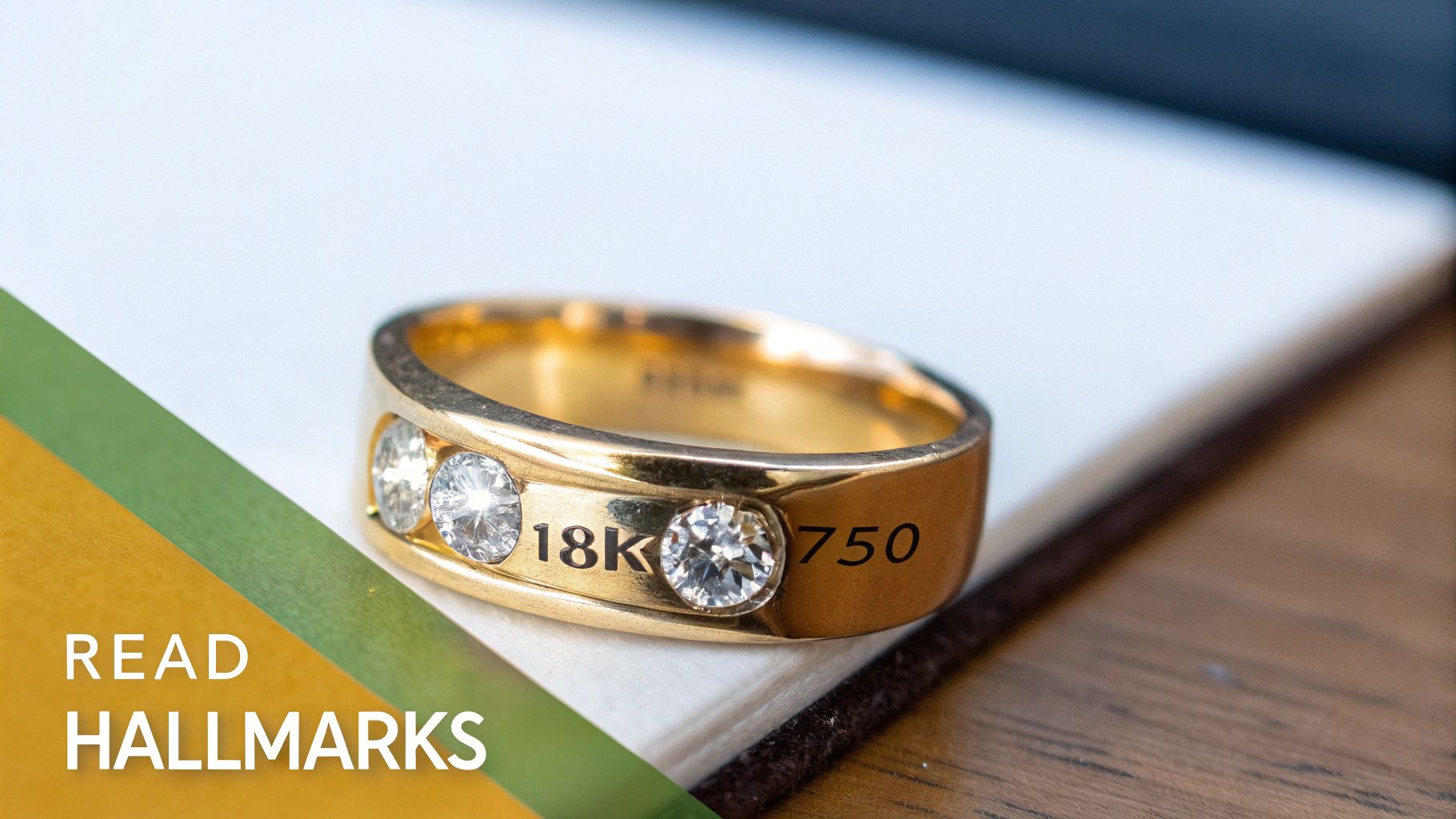
Your jewelry has a story to tell, and it’s written in a tiny language of stamps called hallmarks. Think of these small engravings as a birth certificate for your gold, confirming its purity and where it came from. Learning to read them is the first step in verifying your item’s value with confidence.
These marks are absolutely crucial for figuring out your 18k gold price per gram because they give you a quick, reliable confirmation of its gold content. They’re the jewelry industry’s way of guaranteeing that what you have is the real deal.
Decoding Common 18k Gold Stamps
When you inspect a piece of gold jewelry, you’ll usually find these hallmarks tucked away in an inconspicuous spot, like the inside of a ring band or near the clasp of a necklace. For 18k gold, the stamps are pretty straightforward and tend to follow a few common formats.
Here’s what you should be looking for:
- 18K or 18Kt: This is the most common marking you’ll see in the United States. It explicitly states the item is 18 karat gold. Simple as that.
- 750: Used widely across Europe and internationally, this stamp signifies that the metal is 75% pure gold (or 750 parts per thousand).
- 18K Italy 750: Sometimes you’ll find a combination of stamps that includes the karat, the fineness number, and even the country of origin.
These little marks provide a clear and immediate signal of purity. If you can spot one of these, you have a solid starting point for getting a valuation.
A hallmark is your most immediate clue to an item’s gold content. The ‘750’ stamp is particularly useful because it directly tells you the purity percentage needed to calculate the melt value.
What if There Is No Hallmark?
Do not panic if your jewelry does not have a visible stamp. It happens. Older pieces, custom made items, or jewelry that’s been heavily worn or repaired might have lost their hallmarks over time.
However, the absence of a mark means you cannot verify its purity on your own. In these cases, professional testing is essential. Besides, any reputable gold buyer will not rely solely on stamps anyway. They use precise, non destructive methods like an X Ray Fluorescence (XRF) scanner to get an exact reading of the metal’s composition.
This technology confirms the exact gold percentage without harming your item, ensuring you get a fair and accurate assessment.
If you’re curious about other ways to check your gold, you can learn more about how to test gold purity at home or with a professional. Understanding hallmarks just puts more power in your hands, making the entire selling process that much more transparent.
Get a Real-Time Estimate with a Gold Calculator
Now that you know what goes into calculating gold value, let’s skip the manual math and get right to the good stuff. The easiest and most accurate way to get an up to the minute estimate is to use a tool built for exactly this purpose.
Our Gold Calculator does all the heavy lifting for you. It pulls live market prices that are updated every few minutes and runs the same formula we’ve discussed, giving you a precise valuation without you ever having to leave home. This gives you the power to know exactly what your items are worth before you even think about talking to a buyer.
How to Use the Calculator in Three Easy Steps
Getting an instant estimate for the 18k gold price per gram is incredibly simple. The whole process is designed to be fast, intuitive, and completely transparent, giving you a real world number in just a few clicks.
Here’s all you need to do:
- Select the Karat: Use the dropdown menu and choose 18K. This tells the calculator to use the correct purity of 75% gold.
- Enter the Weight: Weigh your piece on a scale and type that number into the calculator. Make sure to select “Grams” as your unit.
- See Your Instant Estimate: That’s it! The calculator instantly shows you the live melt value of your 18k gold.
This simple tool cuts through the complexity and gives you a fair market value based on live data.
Using an accurate gold calculator provides a clear, data backed starting point. It transforms you from a curious seller into an informed one, ready to enter any negotiation with confidence.
By arming yourself with this information, you gain a solid understanding of what your 18k gold is actually worth today. This knowledge is your best asset, ensuring you can fairly and accurately evaluate any offer you receive. It makes the entire selling process much smoother and far more predictable.
Common Questions About Valuing 18k Gold
To wrap things up, let’s tackle some of the most common questions people ask when they’re figuring out the value of their 18k gold. Think of this as a quick reference guide to help everything click into place before you sell.
Is 18k Gold a Good Investment?
Yes, absolutely. While it’s not the same as holding a pure gold bar, 18k gold is a fantastic way to own gold. With a substantial 75% gold content, its value is directly tied to the live global gold market, giving it real, tangible worth.
You do pay a bit more for the craftsmanship when you buy it as jewelry, but that does not just vanish. The beauty of 18k gold is its perfect balance, it gives you the financial security of a precious metal while being strong enough to wear and enjoy every day.
How Can I Get the Best Price for My Gold?
Getting the best offer comes down to one thing: walking in prepared. When you already know the 18k gold price per gram and have calculated your item’s melt value, you’re in the driver’s seat.
The single best thing you can do? Get quotes from several reputable buyers. This lets you compare offers head to head and makes it obvious who is offering a fair price based on today’s market.
Are White, Rose, and Yellow Gold Valued Differently?
Nope. When it comes to melt value, the color of 18k gold makes no difference. Whether your piece is a warm yellow, a blushing rose, or a cool white, it still contains 75% pure gold, and that’s what determines its base value.
The different colors are created by the other 25% of alloy metals, copper for rose gold, or palladium and silver for white gold, for example. Since the amount of pure gold is exactly the same across the board, their melt values are identical.
Here’s a simple breakdown:
| Gold Color | Pure Gold Content | Alloy Metals (Example) | Base Value |
|---|---|---|---|
| Yellow Gold | 75% | Silver, Copper | Same |
| Rose Gold | 75% | Copper | Same |
| White Gold | 75% | Palladium, Silver | Same |
Ready to see what your gold is worth right now? Use our free Gold Calculator for an instant, transparent estimate based on live market prices.


